Thursday Feb 23, 2023
Brain Fact Friday ”The Damaging Impacts of Sugar on the Brain and Body”
“It’s well understood that this chronic disease (type 2 diabetes) is linked to lifestyle. Combine a diet high in sugar (including fruits, honey, and starch, all of which turn into varying amounts of sugar when digested) with a lack of exercise and the results will be type 2 diabetes with the miserable complications that come with it.” (An excerpt from Dr. Richard Jacoby, co-author of Sugar Crush: How to Reduce Inflammation, Reverse Nerve Damage, and Reclaim Good Health.”
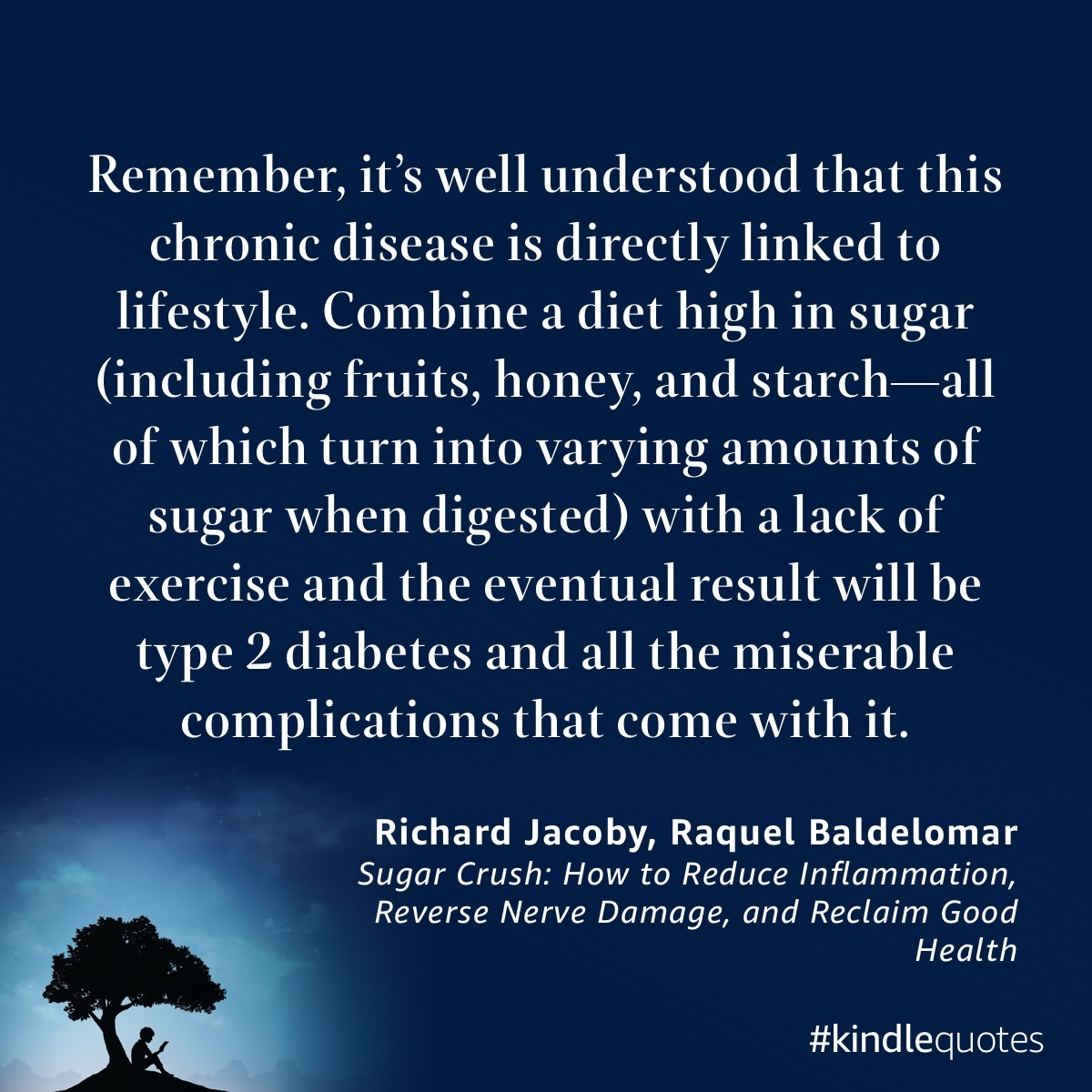
I want to welcome you back to The Neuroscience Meets Social and Emotional Learning Podcast where we bridge the gap between theory and practice, with strategies, tools and ideas we can all use immediately, applied to the most current brain research to heighten productivity in our schools, sports environments and modern workplaces. I’m Andrea Samadi and launched this podcast almost 4 years ago, to share how important an understanding of our brain is for our everyday life and results.
For today’s episode #275, we will revisit one of my favorite episodes #117[i] on “The Damaging Impact of Sugar on the Brain and Body” to review what we covered, and see if there’s anything else important that the research has revealed. There’s a lot that’s NEW with this topic, but as I reviewed this past episode, I had completely forgotten some of the details we covered a few years ago, that are very important.
Today we will cover:
✔What sugar does to the brain, cognition and well-being.
✔How sugar contributes to cognitive decline and Alzheimer's Disease.
✔That we all have individual journeys on our pathway towards optimal health and well-being.
✔Where my health took a turn towards wellness in 2005 and again in 2014 with the hope that my health story will give you some thoughts with your health story.
✔We looked at 2 people’s blood glucose results to see what each person learned from using a glucose monitor.
✔3 Tips You Can Implement Immediately for Improved Health, Clarity and Well-Being.
You can review this past episode by clicking on the link in the show notes but for today’s episode, we are going to dive a bit deeper with what sugar does to the brain, body, cognition and our health by tying in what has emerged since that first episode. We will look at the results of two people who’ve been tracking their blood glucose levels with the Freestyle Libre Glucose Monitor[ii] to see what patterns emerge eating certain foods. The first individual we will look at, had A1C levels that have recently gone into the danger zone, signaling type-2 diabetes, showing an A1C level of over 8.5 on a recent blood test. I’m the second chart, and am not insulin resistant, but know that sugar doesn’t work for me at all. I don’t need a blood test to know that it makes me feel horrendous. My A1C levels sit around 5.8, which is in line with someone on a lower carbohydrate, and higher fat diet.[iii]
This episode is not about the best diet to choose and when I sat down to write this, I quickly saw that this topic of health, especially as it relates to nutrition is such a challenging and difficult one to cover, as not one size fits all. I do want to acknowledge that there are many different diet plans out there, and that I’m not here to say one is better than another. I recognize that it’s downright frustrating when you are doing everything the right way, (eating clean and exercising) and you are seeing zero results. This seems to be especially true in the area of weight loss, where I recently saw a post from Chris Cornell, who shares his weight loss strategies on Twitter, and asked what ended up being a highly controversial question “why are most people unable to achieve significant and sustainable weight (fat) loss through lifestyle modifications?” He added “I’m guessing some people have something amiss with their regulatory mechanism. For many, I believe it’s that they are unable to regulate the crap foods they’ve been eating.”
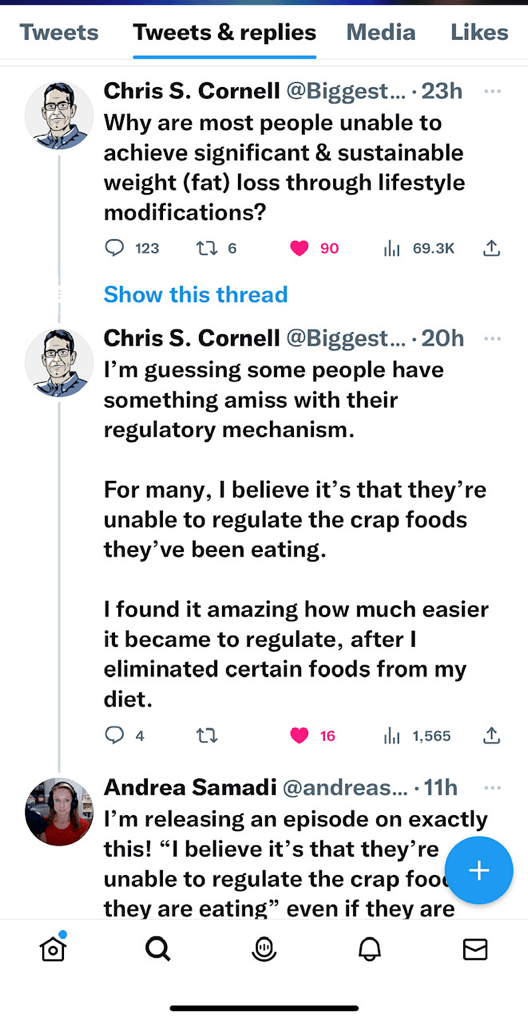
I’ll share what I learned over the past few weeks that might shed some light into why it’s so difficult to make shift with what we eat, and why one bad food choice can often set us up to sabotage ourselves to continue making poor food choices with that snowball effect. Today we will put the focus on what we can control (using the data I uncovered with this glucose monitor) to inform our action steps at the end of this episode. There’s so much to this problem that includes things we can’t control (our heredity, hormones, stress levels to name a few factors) so I’m going to make it easy. Let’s focus ONLY on what sugar does to the brain and body.
I want to acknowledge that we are all different, and your path is probably going to be different from mine, but I’m sure some of what I will share will resonate with you. We all hit a point where we know something isn’t right, and go to the doctor looking for a solution. I really don’t believe in accidents, and when we “feel” like something is off with our health, I think it’s important to listen to our intuition here, and look into it. My journey towards looking for the “right diet” plan began in 2005 (before I had children) when I was looking for a solution for why my feet were going numb during exercise, and there were many twists and turns along the way, before things began to “click” for me.
When I felt that something was off with numbness in my feet, I went to a foot doctor to look for answers. Looking back now, this decision, I think moved the needle of health and wellness the most for me personally over the past 2 decades, as the foot doctor I went to see was Dr. Richard Jacoby, the author of Sugar Crush: How to Reduce Inflammation, Reverse Nerve Damage and Reclaim Good Health.[iv]
Dr. Jacoby[v] took one look at me and said “you don’t look like the typical patient I usually see. People come to me in their late 50s and 60s” (I was around 33 back then and people who were in their 50s (like I am today) were ancient to me so I was starting to think I was in the wrong place). He went on to say that people came in with different types of health problems, and his job was to help them solve these problems.” Over the years, he became excellent with his advice for people, leading him to appear in many of those Top Doctor Lists for 2003, 2005, 2008 and 2010) and he just asked his patients to do 2 things. He asked them to eliminate sugar from their diet, and make sure they are taking omega-3 fatty acids, since most Americans are deficient here.[vi] I started to think maybe my running shoes were too tight and felt bad for wasting his time, as I didn’t think his advice was going to help me, but I looked at him and said, “that’s easy enough” as I was already doing one of his suggestions. Next was to eliminate sugar, which I did, not know how much it would completely change my health.
Of course, our health requires constant work, and this change didn’t last forever. My next turn was around 2014, 10 years later. I remember cooking my children dinner, standing at the stove, and not knowing what I should eat, leading me to google “healthy eating” and that led me to the work of fitness model and trainer, Jason Wittrock[vii], known as the blood sugar king. Jason is on a war against diabetes and obesity, that we will mention a bit later on this episode. The point here is that there’s no straight line. I think we all have our own individual path to figure out with our own “individual secrets” to unlock our optimal levels of health, and I’ve still not figured all of mine out yet, but as I’m approaching age 52, I feel better now, than I did at age 30.
Dr. Jacoby’s book Sugar Crush says it all. He says that:
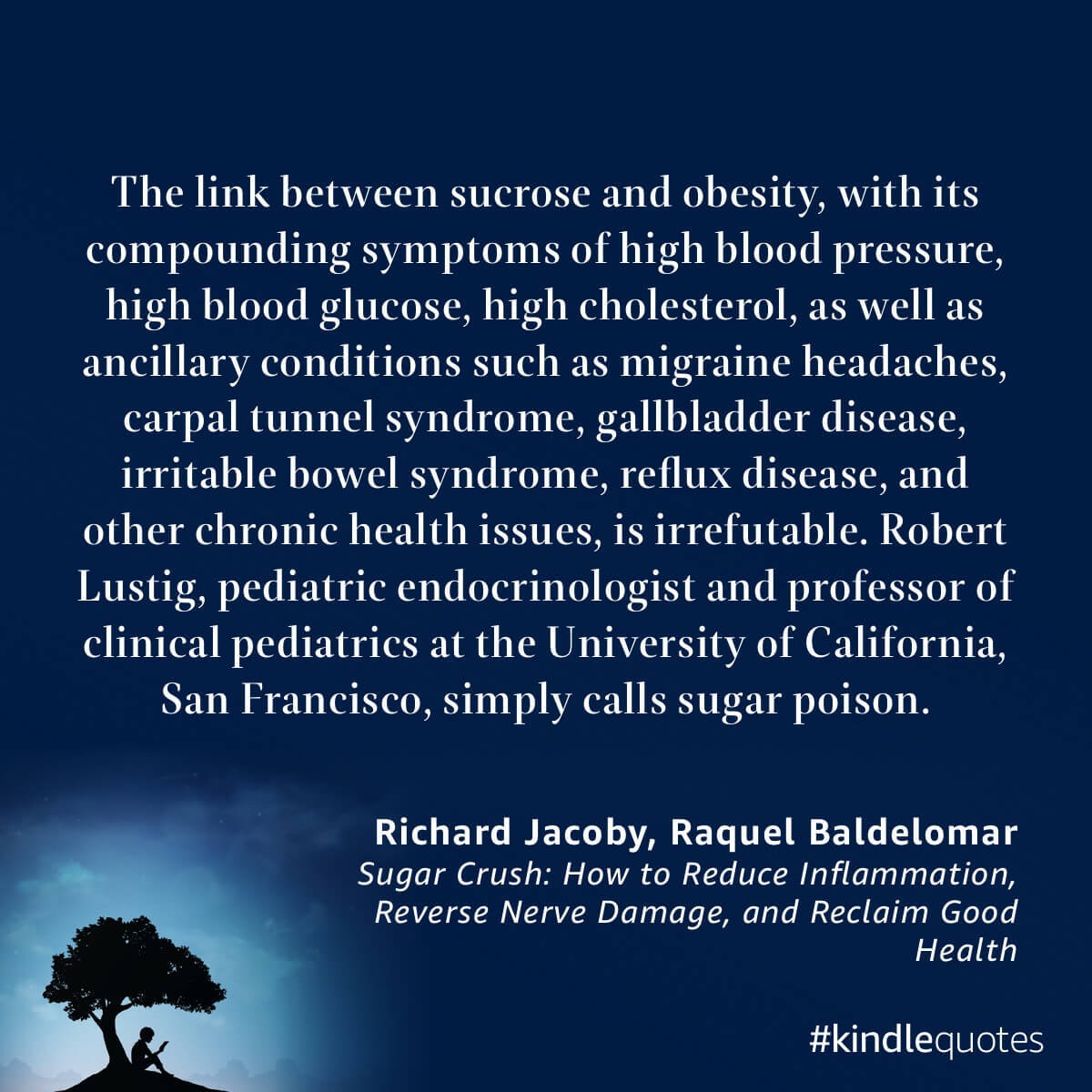
It was not an accident that I ended up at Dr. Jacoby’s offices that day, and I thought about him while actually measuring my glucose levels for this episode.
Before I get to the results of what each of us discovered in this process of measuring our glucose levels, I think it’s important to note what we learned on that first episode that I had forgotten because we can’t remember everything, just what’s important to us—and this is very important at the moment.
Since last week’s episode was about “Building a Faster, Stronger, Resilient Brain, by Understanding Brain-Derived Neurotrophic Factor (BDNF)”[viii] or the compound that Dr. Ratey says is crucial for preventing cognitive decline and Alzheimer’s Disease. I want to focus this episode on something Dr. Ratey said that really made me think.
He said, did you know that “High glucose levels are toxic to the brain, and limits the production of this glorious compound BDNF that has such a profound effect on cognition and well-being?”
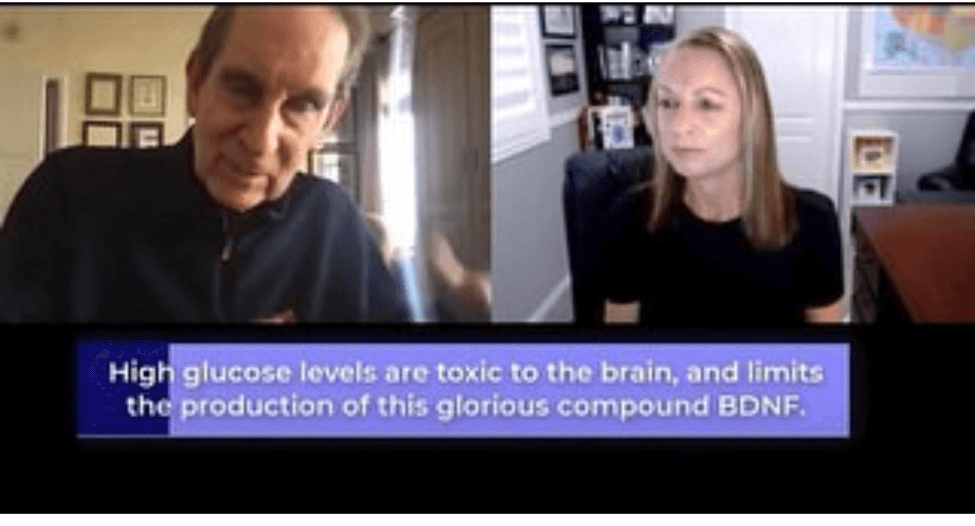
Dr. Ratey’s quote made me think back to a BONUS episode I did for Podbean’s Wellness week[ix] that goes right along with what Dr. Ratey said. It was a quote from Dr. David Perlmutter, who wrote the foreword to Dr. Ratey’s book Go Wild![x] and it was Dr. Perlmutter’s documentary on Alzheimer’s Disease that made me think hard about our Top 5 Health and Wellness staples.
Dr. Perlmutter said DID YOU KNOW THAT: Sugar in the brain “looks like Alzheimer’s” in the brain, and that “60% of cognitive decline is related to how you handle blood sugar?”[xi] He says that “elevated blood sugar shrinks the brain.” I had to take these words and create a visual to bring this to light. Sometimes you can hear the words of something, but until you can actually see and feel the words come to life, like the image I put in the show notes, there isn’t as much meaning to what we might be reading. I think the image of a healthy brain, next to a severely shrunken Alzheimer’s brain, is an image I’ll never forget. Sugar can cause a brain to shrink and look like this.

Remember that quote from Dr. Dale Bredesen from our last episode that said:

- Why would any of us knowingly choose this for ourselves?
- Why would we buy each other gifts at holidays that include things that science reveals are toxic to the brain?
- Why do teachers reward children with candy at school?
- Why do we stand around eating cake at the end of a church service?
I know, because it tastes good. But it’s here we will take the information we are learning, connect the dots to form knowledge and then apply this knowledge to become wise. This is where we go from theory to practice with this podcast.
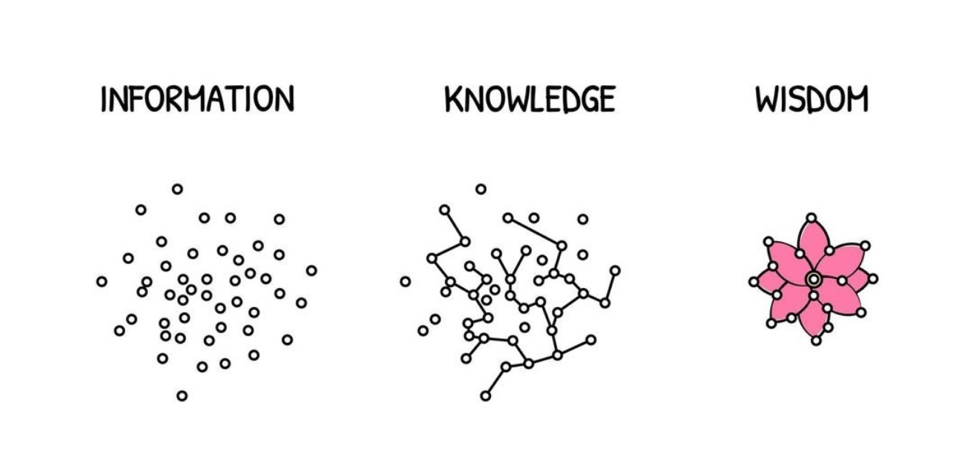
I might be told I’m a bit on the boring side these days, as I’m cutting out all the food that are fun for us, but I’m doing this with the purpose of improving clarity, focus and performance on a day to day basis.
WHAT DID WE LEARN BY MEASURING BLOOD SUGAR LEVELS?
I’m sure you’ve seen people measuring their blood sugar, and sharing how this data helps them to make better choices with the foods they eat. I first saw this device with Jason Wittrock,[xii] who we mentioned earlier, and interviewed on EP 94[xiii]. If you go to his Instagram page, you’ll see many tests he’s done with a variety of different foods, drinks and snacks to see how each one affects his blood sugar levels, and there were many surprises.
If you're curious, go to his page and look at his tests, especially when he tested white rice. It was interesting that hot white rice spiked his blood sugar into the danger zone, but when he applied the cooling theory and put the rice in the fridge for 24 hours, it kept his blood sugar in the safe zone. He mentions at the end of every episode that the foods that took his blood sugar into the danger zone should be avoided by someone who is insulin resistant or who has type 2 diabetes.
Week 1: Feb 3-10
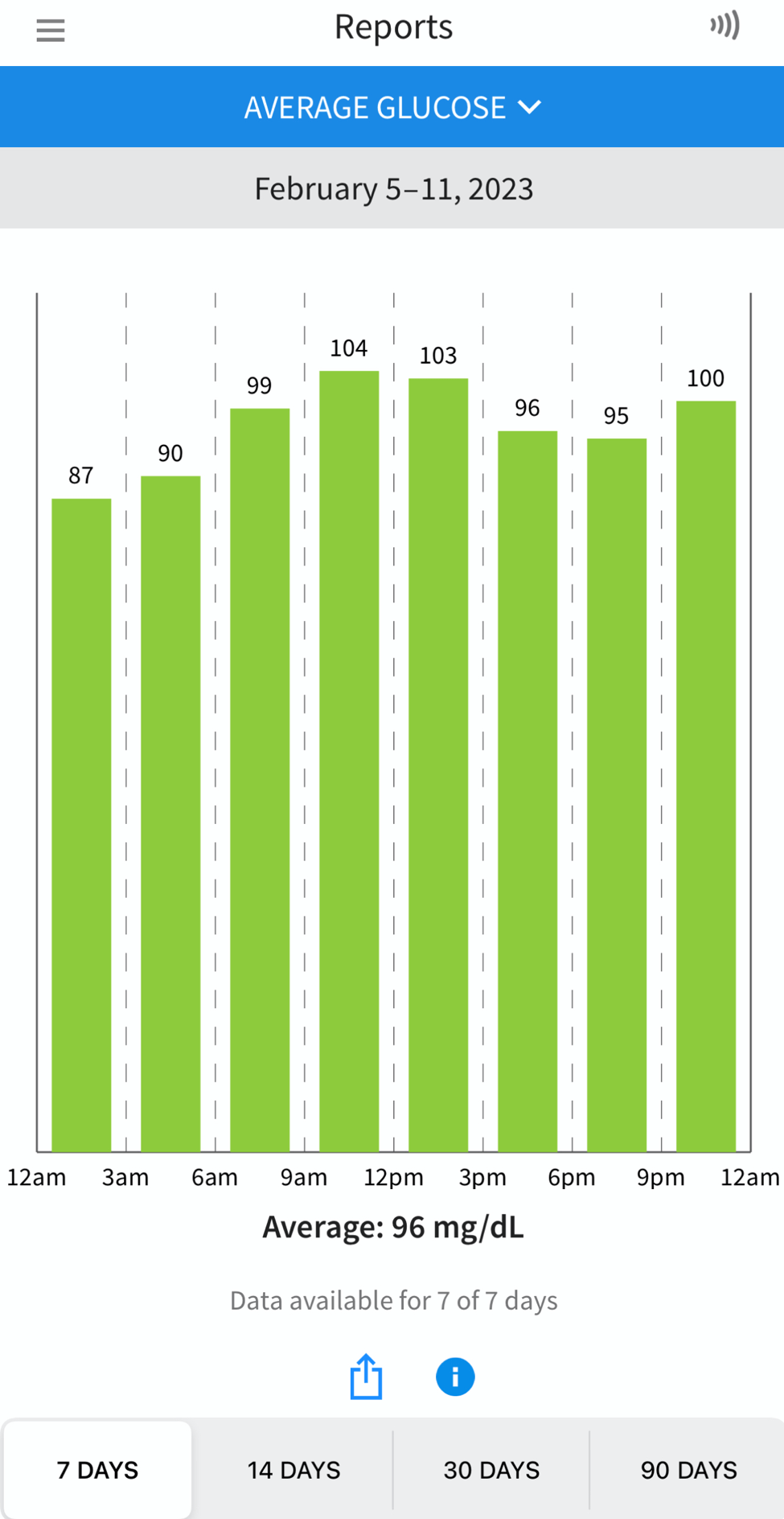
You can see my week one blood sugar averages as very stable, around 96 mg, with no spikes anywhere.
That first week, I almost gave up measuring as I pretty much eat the same foods every day and I was getting the same spikes every day. Around 9am I eat breakfast (usually Ezekiel bread with peanut butter) and you can see this is typically when my blood sugar spikes the most, around 9am. Since I’m not diabetic, my blood sugar goes back to normal pretty quickly.
Around 12pm I’ll have a protein shake with almond milk, (with strawberries, avocado, spinach and fiber) that doesn’t spike blood sugar, and usually around 3pm I’ll have eggs (sometimes with bacon) with the other avocado half. Everything on my chart was predictable, no surprises, even on the days that I ate some chocolate, something I do when I have writing blocks. Since I’m not diabetic or insulin resistant, small amounts of sugar don’t seem to do much to my blood sugar.
But look at what happened when I travelled in week 2.
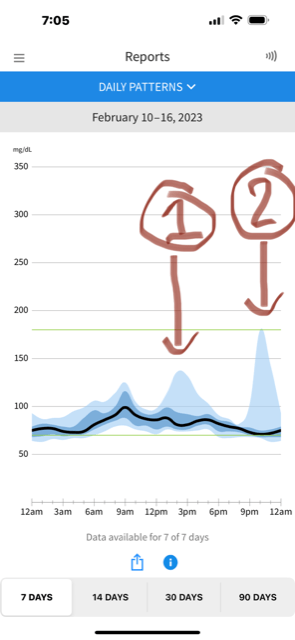
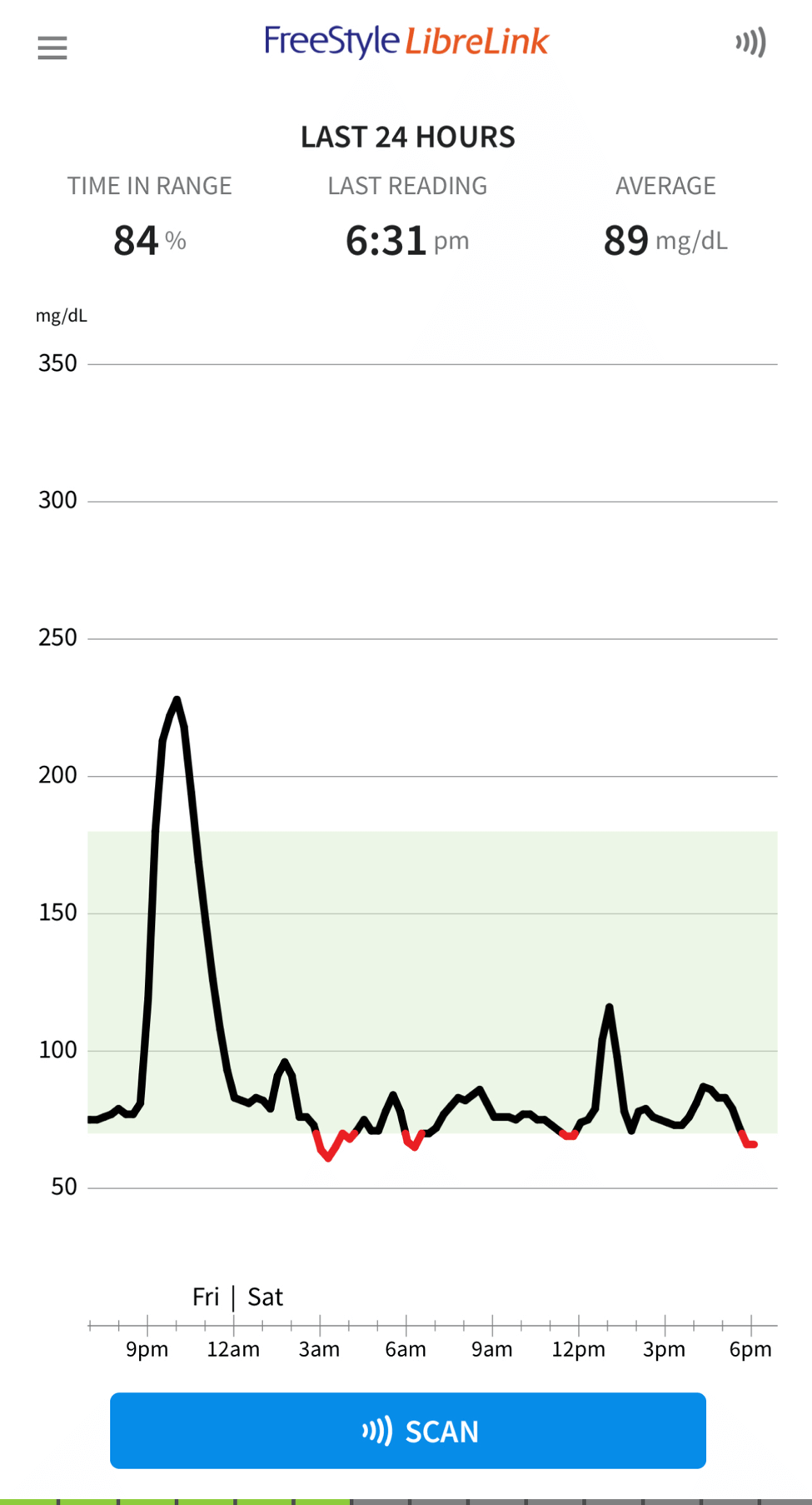
Week 2, I was away from home, and ate something I don’t usually eat. Normally, I bring food with me when I travel, as it does save money and time trying to find a place to eat, but this time, it was a quick trip, so I didn’t.
Look at the second graph in the show notes and you can see what happened when I was away for the weekend. You will see 2 times my blood sugar rose up. Once with a turkey sandwich on whole wheat bread from a place called Jersey Mikes around 3pm, and again around 9pm that night. I usually follow an eating schedule where I would never eat past 5:30pm at night (intermittent fasting where I don’t eat for a 16 hour window, and eat healthy foods in an 8 hour window) but the event we were at ended late, so a group of us decided to order food from a local Thai restaurant. I love Thai food (especially Pad Thai) so that’s what I ordered. This meal (that was delicious) but it took my blood sugar way over 200, putting me in the danger zone with this meal. It did stable out in the night, but here’s what was interesting for me. Whenever I eat something off my usual plan, I feel starving the next day. It just messes up the whole next day for me, and while it was worth it to sit and enjoy a meal with others, it is good to know what happens to our body when we overload it with high glucose foods.
If you look at the second graph, the next day, my blood sugar kept dipping too low (where it dipped low and was showing red, was when I felt insanely hungry) and it would’ve been easy to eat something else off the usual menu, showing how one choice can impact the series of choices you make over the next few days. This was eye-opening to me.
Now let’s look at the graph of someone who has just crossed the threshold of being diabetic. I didn’t even pick a sugary food for this example, which would have obviously spiked blood sugar.
What happens to someone who is diabetic?
“Diabetes is a problem with your body that causes blood sugar (also called blood glucose) levels to rise higher than normal. This is also called hyperglycemia. When you eat, your body breaks food down into sugar and sends it into the blood. Insulin then helps move the sugar from the blood into your cells.”[xiv]
For a person with diabetes, there is a problem with insulin. But, not everyone with diabetes has the same problem. There are different types of diabetes—type 1, type 2 and gestational diabetes. If you have type 2 diabetes, your body does not use insulin properly. This is called insulin resistance. At first, your cells make extra insulin to make up for it. But, over time your pancreas can't make enough insulin to keep your blood sugar at normal levels. Type 2 diabetes develops most often in middle-aged and older adults but can appear in young people.
WEEK 1 with TYPE 2 DIABETIC PERSON:
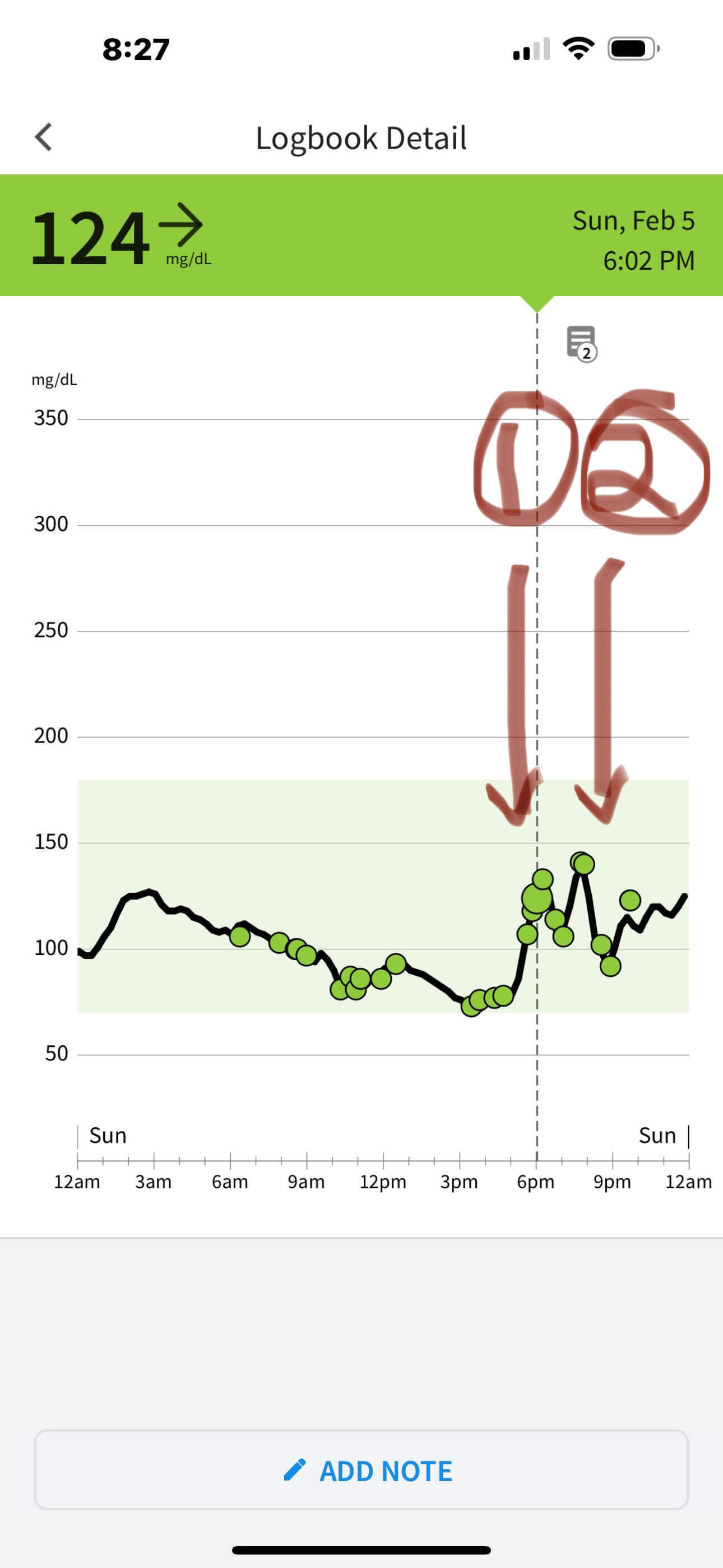
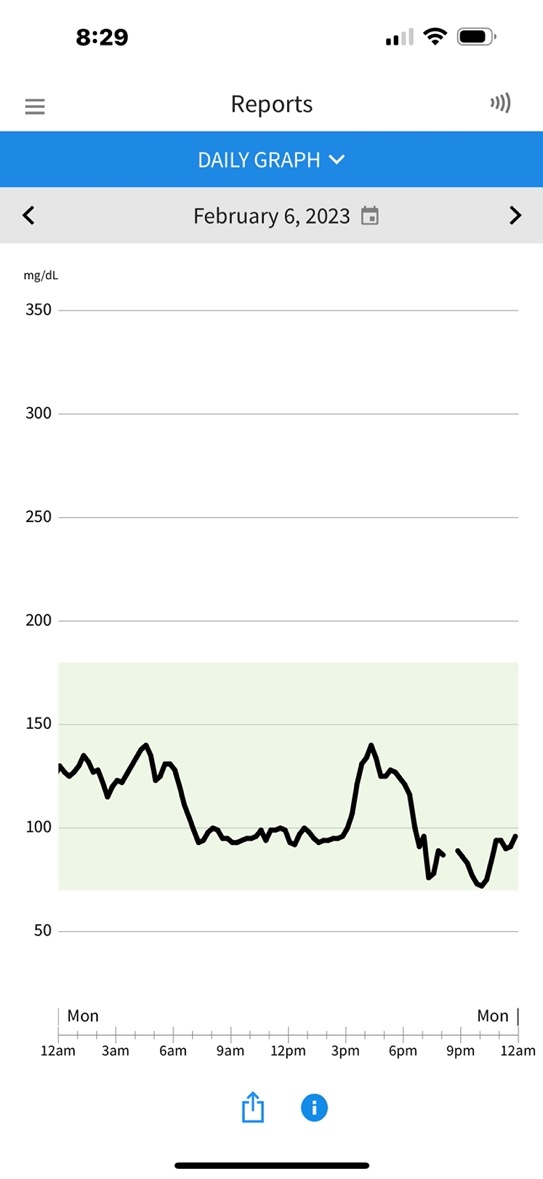
Week 1 he noticed spikes with foods that were high in carbs (like bread) that stayed high well into the night and only started to come down to normal levels by 9am. The obvious take-away from this was that for someone who has passed the threshold with diabetes, or in the danger zone that they will eventually need to see the doctor to take medicine to keep their blood sugar levels stable. For some people, diet and exercise could be the answer to regulate blood sugar, but if your blood sugar is staying high, for too long, remember “glucose in the brain is toxic to the brain” and that “elevated blood sugar shrinks the brain” or even that “sugar in the brain looks like Alzheimer’s in the brain. If you are insulin resistant or have type 2 diabetes, then knowing how your body reacts to sugar could be the difference between life and death.
WEEK 2

Be careful of thinking "I've got this" and make a poor food choice. Here's the graph after eating homemade pizza. A better choice for pizza dough would be cauliflower pizza dough that you can find at your local grocery store that keeps blood sugar levels stable.
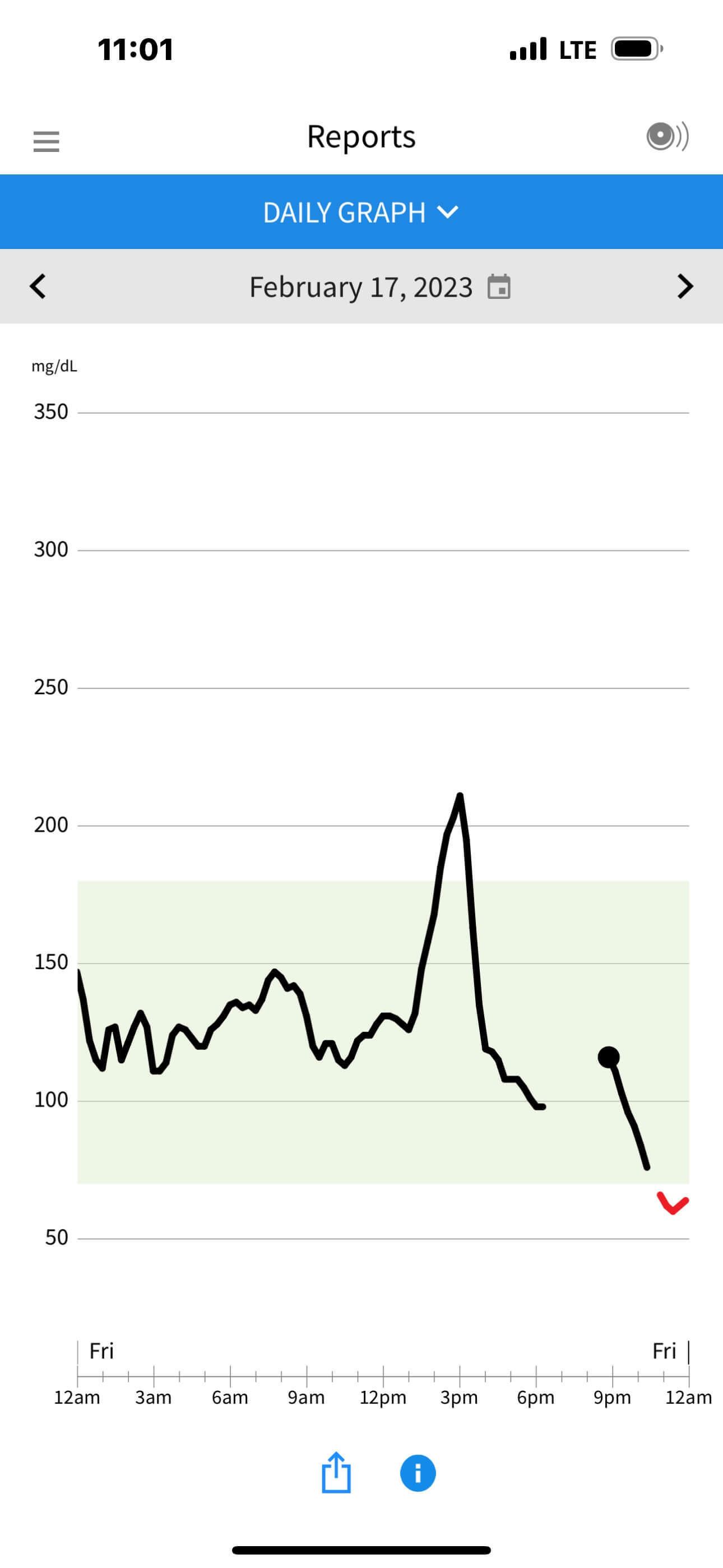
Once you have seen and felt a blood sugar spike, especially for someone working hard to keep their blood sugar levels stable, this was enough to make this person choose foods that did not cause a blood sugar spike and glucose levels remained under 150. Until they thought “oh I’ve got this blood sugar thing” and made homemade pizza with store bought dough, you will see this raised his blood sugar well into the danger zone over 200, just like my Pad Thai.
REVIEW AND CONCLUSION
So taking what we learned from our last episode on the damaging impacts of sugar on the brain, we know that glucose is toxic to the brain, so a person with this data would now need to make a data informed decision to not eat foods that spike their blood sugar.
This is one of those things that’s easier said than done. How do you make huge lifestyle changes like this? I think it gets to the point that you’ll do it if your life depends on it. Like I remember that math teacher, Sergei with tears in his eyes on the hiking trail. You’ll make changes when your doctor tells you loud and clear you have no other option.
Make room for your health or you’ll need to make room for your illness.
We will conclude this episode with some tips on how to make actionable changes if you don’t know where to begin in your journey towards improved health and well-being.
TIP 1: LEARN WHAT FOODS ARE LOW-GLYCEMIC and replace what you used to eat (that spiked your blood sugar) with something else that doesn’t. This is going to be the biggest change as I remember looking at Dr. Jacoby and saying, “you mean bananas are high in sugar?” and he said “yes” and handed me a list of low glycemic fruits that included blueberries and raspberries (that Jason Wittrock tested and they kept his blood sugar low). I found some great resources for low glycemic foods from Dr. Daniel Amen.[xv]
TIP 2: DISCOVER THE MEAL PLAN THAT MAKES YOU FEEL THE BEST: There’s so many different options and I only chose the meal plan I eat because in my late 20s I was diagnosed with Polycystic Ovarian Syndrome[xvi] (the most common causes of female infertility) and who would have known that the diet plan that would work the best for me, and completely reverse this health problem, was to eat a diet similar to someone who is diabetic. I bought the PCOS Diet Book[xvii] that surprisingly was written to also help protect someone against diabetes and heart disease.
TIP 3: READ LABELS Read Labels and Know How to Identify Sugar to Make Better Choices: It’s shocking how many foods have hidden sugars. Did you know “The average American consumes 150 lbs. of sugar a year” (Dr. Amen) This makes sense when there’s so many foods labeled as healthy, with hidden sugars added.
Making the following changes will change your brain, improve cognition, focus and help lead you towards improved results, and away from diabetes and Alzheimer’s Disease.
I hope you find these tips as helpful as I did. I only discovered this pathway because I so happened to book an appointment with a doctor who believes that peripheral neuropathy (that numbness I felt in my feet during exercise) is an early sign for what he’s seen in his patients over the years…
The final thoughts come from Dr. Jacoby, who pleads with us:
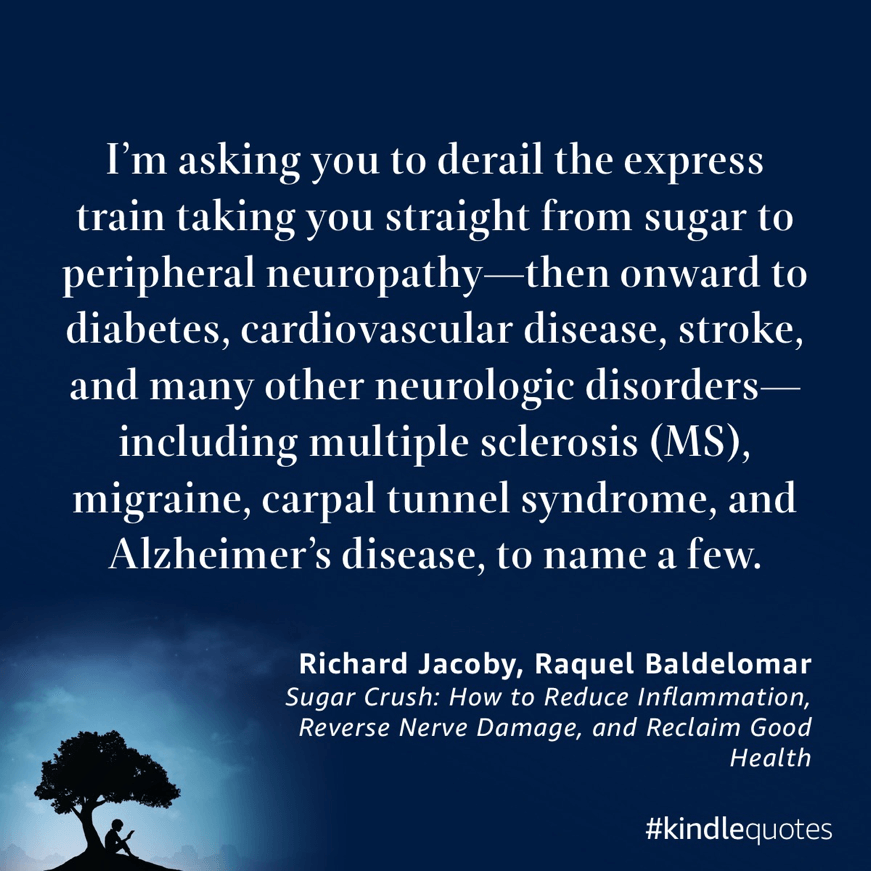
I’d love to hear what you think of this episode! Do you know how YOUR body responds to sugar? Have you ever measured your glucose levels? This data will help inform many of your decisions related to the foods you will eat. I know I’m going to stick to eating those low glycemic foods that keep my blood sugar levels and hunger levels stable, until I make it back to my hometown in Toronto, where I’ll order a Hawaiian slice at the famous Pizza Pizza with extra pineapple, and I’ll enjoy every bite of it, because you only live once!
I’ll see you next week as we revisit EP #119 on “The Key Ingredients of Learning with the Brain in Mind”
FOLLOW ANDREA SAMADI:
YouTube Channel: https://www.youtube.com/c/AndreaSamadi
Website https://www.achieveit360.com/
LinkedIn: https://www.linkedin.com/in/samadi/
Facebook: https://www.facebook.com/Achieveit360com
Neuroscience Meets SEL Facebook Group https://www.facebook.com/groups/2975814899101697
Twitter: https://twitter.com/andreasamadi
Instagram: https://www.instagram.com/andreasamadi/
REFERENCES:
[i]Neuroscience Meets Social and Emotional Learning Podcast EPISODE #117 “The ‘Damaging Impact of Sugar on the Brain and Body” https://andreasamadi.podbean.com/e/brain-fact-friday-on-the-damaging-impact-of-sugar-on-the-brain-and-body-with-andrea-samadi/
[ii] https://www.freestyle.abbott/us-en/home.html
[iii] Lower carbohydrate and higher fat intakes are associated with higher hemoglobin A1c: findings from the UK National Diet and Nutrition Survey 2008-2016 https://www.ncbi.nlm.nih.gov/pmc/articles/PMC7413867/
[iv] Sugar Crush: How to Reduce Inflammation, Reverse Nerve Damage and Reclaim Good Health by Dr. Richard Jacoby (April 2014) https://www.amazon.com/dp/B00KPVB4OA/ref=dp-kindle-redirect?_encoding=UTF8&btkr=1
[v] http://phoenixfootcarenetwork.com/
[vi] Study finds most Americans low in omega-3 fatty acids Published May 24, 2021 by Danielle Masterson https://www.nutraingredients-usa.com/Article/2021/05/24/Study-finds-most-Americans-low-in-omega-3-fatty-acids-could-impact-mood#:~:text=Subscribe-,Study%20finds%20most%20Americans%20low%20in%20omega,fatty%20acids%2C%20could%20impact%20mood&text=New%20research%20has%20found%20that,on%20the%20US%20Dietary%20Guidelines.
[vii] Jason Wittrock https://www.instagram.com/jason.wittrock/?hl=en
[viii] Neuroscience Meets Social and Emotional Learning Podcast EPISODE #114 on “Building a Faster, Stronger, More Resilient Brain by Understanding Brain Derived Neurotrophic Factor or BDNF” https://andreasamadi.podbean.com/e/brain-fact-friday-on-building-a-faster-stronger-resilient-brain-by-understanding-brain-derived-neurotrophic-factor-bdnf/
[ix] Neuroscience Meets Social and Emotional Learning Podcast BONUS EPISODE “Review of the Top 5 Health Staples Created for Podbean’s Wellness Week” https://andreasamadi.podbean.com/e/bonus-episode-a-deep-dive-into-the-top-5-health-staples-and-review-of-seasons-1-4/
[x] Go Wild: Eat fat, Run Free, Be Social, and Follow Evolution’s Other Rules for Total Health and Well-Being by John J. Ratey, MD and Richard Manning (June 3, 2014) https://www.amazon.com/Go-Wild-Free-Afflictions-Civilization-ebook/dp/B00FPQA66C
[xi] Dr. David Perlmutter’s “Alzheimer’s: The Science of Prevention” https://scienceofprevention.com/
[xii] https://www.instagram.com/jason.wittrock/?hl=en
[xiii]Neuroscience Meets Social and Emotional Learning Podcast EPISODE #94 with Jason Wittrock on “Health, Intermittent Fasting, and the Ketogenic Diet” https://andreasamadi.podbean.com/e/personal-trainer-and-fitness-model-jason-wittrock-on-health-nutrition-intermittent-fasting-and-the-ketogenic-diet/
[xv] 4 Feel Better Food Strategies by Daniel Amen https://www.amenclinics.com/blog/4-feel-better-fast-food-strategies/#:~:text=Most%20vegetables%2C%20legumes%2C%20and%20fruits,blood%20sugar)%20are%20smart%20carbs.[xvii] The PCOS Diet Book by Collette Harris https://www.amazon.com/PCOS-Diet-Book-nutritional-polycystic/dp/0007131844
2 years ago
This is such awesome content! Love your work and am so grateful for you!